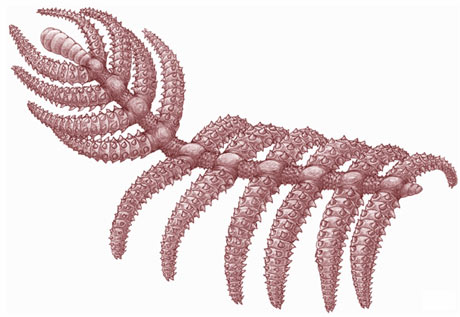 |
| A fossil of the enigmatic Diania cactiformis |
Eventually it was placed with the lobopodians, a poorly understood group of arthropods which have often been described as worms with legs. A recent study of the three or so complete specimens alongside 30 odd fragments by Chinese and German palaeontologists, led by Jiani Liu from the Northwest University in Xi'an, believe that its relationships to other lobopods, such as tardigrades or velvet worms, as well as the rest of the armoured invertebrate world, may be rather different to their current definitions.
 |
| A reconstruction of the 'walking cactus' Diania cactiformis |
This led the palaeontologists to the theory that the group Lobopodia is not actually a separate group of arthropods, but instead a name given to a collection of organisms who happen to share a similar body plan rather than a close evolutionary relationship. As Diania is one of the most primitive lobopods, lobopods are still arthropods and also some of the most primitive, the team logically concluded that this strange, cactus-like creature is one of the oldest arthropods on Earth, and perhaps even, the first ever.
As the Cambrian biota evolved from the mysterious Ediacara biota, organisms whose body plans are neither truly plants, animals or fungi, it seems likely that Diania, due to its bizarre mix of plant and animal characteristics, could represent the missing link between Ediacarans such as Spriggina or Dickinsonia and the rest of the arthropod kingdom. New and better preserved fossils of these strange intermediate forms will either confirm or dispel these theories.